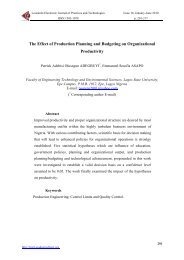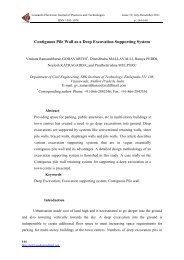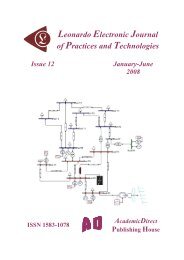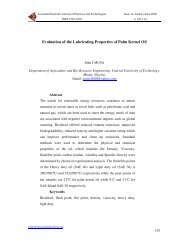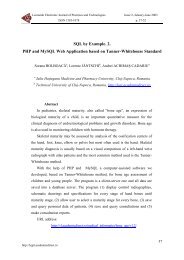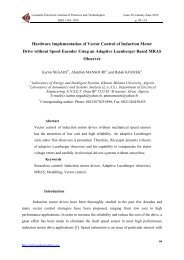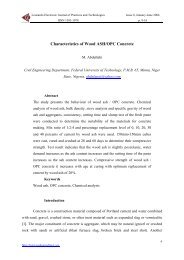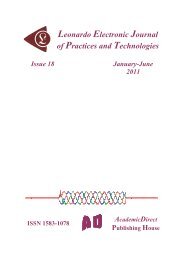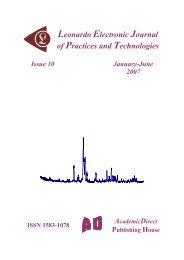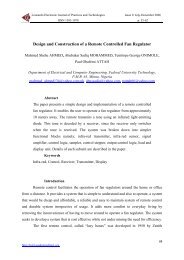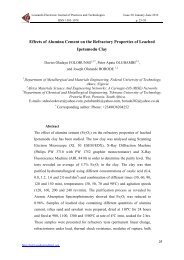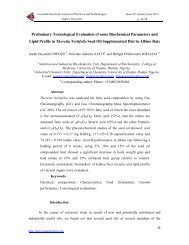p. 106-121 - Leonardo Electronic Journal of Practices and ...
p. 106-121 - Leonardo Electronic Journal of Practices and ...
p. 106-121 - Leonardo Electronic Journal of Practices and ...
Create successful ePaper yourself
Turn your PDF publications into a flip-book with our unique Google optimized e-Paper software.
<strong>Leonardo</strong> <strong>Electronic</strong> <strong>Journal</strong> <strong>of</strong> <strong>Practices</strong> <strong>and</strong> Technologies<br />
ISSN 1583-1078<br />
Issue 13, July-December 2008<br />
p. <strong>106</strong>-<strong>121</strong><br />
The critical unit in the galvanizing process is the galvanizing kettle (the zinc pot). This<br />
unit made <strong>of</strong> low-carbon low silicon steel is rectangular in framework <strong>and</strong> is where the actual<br />
galvanizing is accomplished. The chemical reaction <strong>of</strong> the galvanizing process takes place in<br />
the kettle. After several cycles <strong>of</strong> operation, the inside <strong>of</strong> the kettle is attacked by molten flux,<br />
zinc <strong>and</strong> dross. The attack is aggravated by temperature fluctuations. This leads to erosion <strong>and</strong><br />
builds up <strong>of</strong> deposit <strong>and</strong> ultimately cracks in the kettle [9]. The success <strong>of</strong> the galvanizing<br />
process is highly affected by the integrity <strong>of</strong> the galvanizing kettle. Therefore, there is<br />
motivation to investigate the loss in integrity <strong>of</strong> the galvanizing kettle as a result <strong>of</strong> the<br />
interaction <strong>of</strong> these factors with a view to determining optimum conditions <strong>of</strong> flux, dross <strong>and</strong><br />
production temperature necessary for enhancing the lifespan <strong>of</strong> a typical galvanizing kettle.<br />
The present work discussed the findings from studies into the effect <strong>of</strong> factors such as<br />
amounts <strong>of</strong> flux, dross <strong>and</strong> production temperature on the service integrity <strong>of</strong> galvanizing<br />
kettle. The object <strong>of</strong> the studies is to evaluate means <strong>of</strong> improving the lifespan <strong>of</strong> the<br />
galvanizing kettle. The investigation involved studying the effect <strong>of</strong> temperature on localized<br />
wear <strong>of</strong> the kettle <strong>and</strong> that <strong>of</strong> intermetallic dross on the capacity <strong>of</strong> the galvanizing kettle.<br />
Besides, the contribution <strong>of</strong> flux to intermetallic dross is reported.<br />
Material <strong>and</strong> Method<br />
Sourcing <strong>of</strong> Material<br />
Production data were collected from Galvanizing Industries Limited, Oba Akran<br />
Road, Ikeja Industrial Estate, Nigeria. The data collected spanned three year production<br />
schedule. Other materials are analar grade saturated solution <strong>of</strong> sodium carbonate, 6M nitric<br />
acid, 0.1M silver nitrate, sodium hydroxide.<br />
The constituent components <strong>of</strong> the galvanizing process are the zinc pot (galvanizing<br />
kettle), the flux box, the zinc box, pyrometer, inner guide <strong>and</strong> chemical. The critical unit in<br />
the galvanizing process is the zinc pot. A cross-sectional representation <strong>of</strong> the galvanizing<br />
kettle is given in Figure 1.<br />
108



